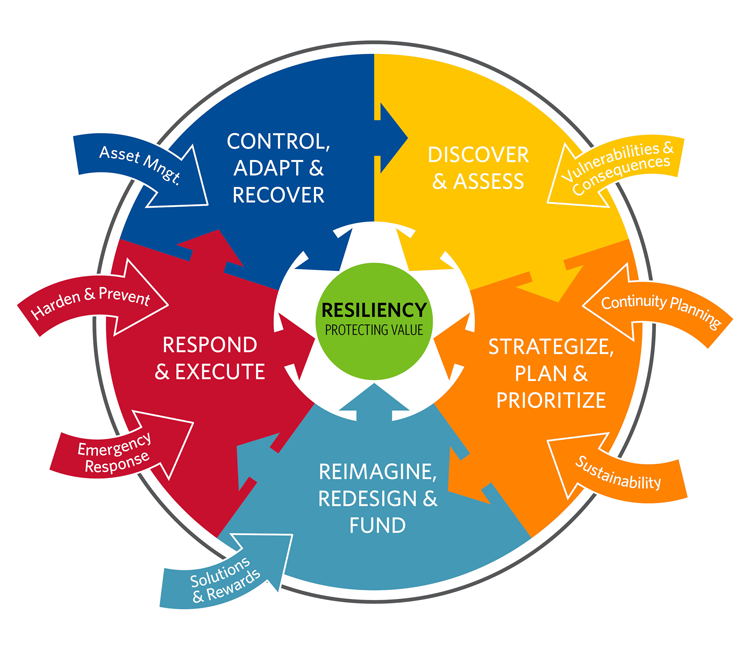
HDR’s Resiliency Planning Framework Results in Long-Term Solutions
A Holistic Approach Built on a Strong Technical Foundation
Climate resilience is not an isolated issue; it is a holistic approach to hazard/risk management that enables people to effectively assess risks, communicate potential impacts and make data-driven decisions to prioritize resilient actions. Our communities — everyone in them — benefit from the mitigation of impacts to our environmental, economic, physical and especially social well-being. The goal of building system resilience is to enable communities and their infrastructure systems to realize service continuity and functionality amidst chronic stressors (such as the impacts of climate change) and acute shocks (such as earthquakes and extreme storms). Additionally, it is a value proposition that, when successful, resonates through policy and procurement by generating resources such as funding and technical assistance to produce equity for all.
Based on project lessons learned and our own in-depth research, our team has developed a holistic approach to resiliency that represents a policy of resilience that stands on a strong technical foundation. This resiliency framework is designed to produce flexible, mitigating actions that strengthen infrastructure and the communities that it serves. Using this approach, we assist communities in preparing effective and long-lasting resiliency strategies.
HDR Resiliency Planning Framework
The Importance of Engagement
Before any technical analysis can begin, it is extremely important to expand the reach and knowledge base for what is trying to be achieved. Having the support, commitment and involvement from the right stakeholders is critical to the credibility and longevity of a risk assessment and any adaptive actions that may come from strategic adaptive planning. The stakeholder’s institutional knowledge can improve quality, acceptance and effectiveness of a resiliency plan. Collaborative decisions are more robust and transparent. The framework also addresses broader community engagement through strategic communications that provide general awareness, periodic feedback and consultation.
Components of the HDR Resiliency Planning Framework

Discover and Assess
The process begins with the identification of all system assets to be assessed. This is generally performed within a GIS setting utilizing existing databases, which include, but are not exclusive to, digital elevations, design specifications and imagery. Once the system has been data-based, threats are identified in a scenario building exercise and applied to the systems to identify vulnerabilities and assess consequences (criticality) of failure. Institutional knowledge gained through the strategic communication vehicles that are part of the resiliency framework play a large role determining system criticalities as they relate to social, economic and environmental goals. These findings can be developed into a risk analysis that utilizes the risk equation to identify and quantify risk levels: Likelihood X Consequences = Risk.
Strategize, Plan and Prioritize
In the next phase, identified risk is used to vet and prioritize resilient solutions. Components include development of adaptive measures that consider feasibility, business continuity, sustainable processes, effectiveness and long-term planning goals. This, too, is a collaborative effort that requires facilitation and relies heavily on the foundation developed through early stakeholder engagement.
Reimagine, Redesign and Fund
This is the part of the framework where solutions, innovation, imagination and policy are turned into reality. Of course, this piece of the resiliency puzzle is not complete without a means to fund resilient activities. While traditional sources of funding such as tax revenue, rate structures, bonds and ballot measures are always possible, there is an enormous amount of grant and cost-share funding for resiliency available from private, public, federal and even international sources that can be leveraged in this phase.
Respond and Execute
Resiliency planning is performed for a reason. There will come a time when disaster strikes?whether it is a near-term threat of a major hurricane or the chronic threat of steadily rising seas or air temperatures. Therefore, emergency response needs to become part of the resiliency equation. This phase enables current emergency response planning to be incorporated into resiliency planning. This offers opportunities for collaboration, creating a two-way street where emergency responders learn from and incorporate resilient actions into their plans.
The only thing more difficult than planning for an emergency is explaining why you didn’t.
Control, Adapt and Recover
This phase develops planning to guide system recovery in a post-event mode. Strategies focus on being proactive rather than reactive to a major disaster, including asset management, long-term logistical planning, and even pre-positioned documentation/contracting designed to speed and aid the recovery process.
An Iterative Approach
This framework is designed as an iterative approach to resiliency that can live on within the non-proprietary GIS platform developed to provide a basis for a resiliency study. It can adjust to reanalyze risk and levels of resilience as infrastructure and risk profiles change.
